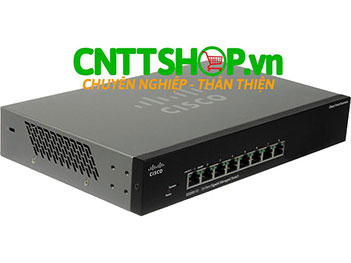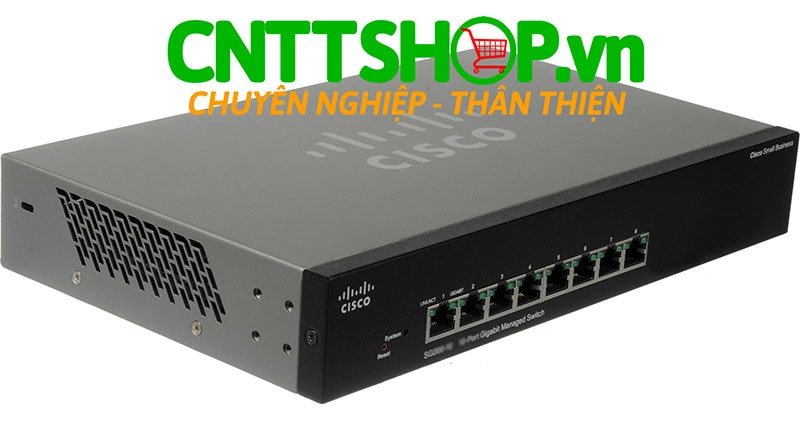|
Layer 2 switching
|
|
Spanning Tree Protocol (STP)
|
Standard 802.1d spanning tree support
Fast convergence using 802.1w (Rapid Spanning Tree Protocol [RSTP]), enabled by default
Multiple spanning tree instances using 802.1s (MSTP); 8 instances are supported
|
|
Port grouping/link aggregation
|
Support for IEEE 802.3ad Link Aggregation Control Protocol (LACP)
- Up to 4 groups
- Up to 8 ports per group with 16 candidate ports for each (dynamic) 802.3ad LAG
|
|
VLAN
|
Support for up to 256 active VLANs simultaneously
Port-based and 802.1Q tag-based VLANs
Management VLAN
Guest VLAN
|
|
Voice VLAN
|
Voice traffic is automatically assigned to a voice-specific VLAN and treated with appropriate levels of QoS. Auto voice capabilities deliver networkwide zero-touch deployment of voice endpoints and call control devices
|
|
Generic VLAN Registration Protocol (GVRP)and Generic Attribute Registration Protocol (GARP)
|
Protocols for automatically propagating and configuring VLANs in a bridged domain
|
|
IGMP (versions 1, 2, and 3) snooping
|
Internet Group Management Protocol (IGMP) limits bandwidth-intensive multicast traffic to only the requesters; supports 4K multicast groups (source-specific multicasting is also supported)
|
|
IGMP querier
|
Used to support a Layer 2 multicast domain of snooping switches in the absence of a multicast router
|
|
HOL blocking
|
Head-Of-Line (HOL) blocking
|
|
Loopback detection
|
Provides protection against loops by transmitting loop protocol packets out of ports on which loop protection has been enabled. It operates independently of STP
|
|
Layer 3 routing
|
|
IPv4 routing
|
Wire-speed routing of IPv4 packets
Up to 32 static routes and up to 16 IP interfaces
|
|
IPv6 routing
|
Wire-speed routing of IPv6 packets
|
|
Layer 3 interface
|
Configuration of Layer 3 interface on physical port, LAG, VLAN interface, or loopback interface
|
|
Classless Interdomain Routing (CIDR)
|
Support for CIDR
|
|
DHCP relay at Layer 3
|
Relay of DHCP traffic across IP domains
|
|
User Datagram Protocol (UDP) relay
|
Relay of broadcast information across Layer 3 domains for application discovery or relaying of bootP/DHCP packets
|
|
Security
|
|
SSL
|
Secure Sockets Layer (SSL) encrypts all HTTPS traffic, allowing secure access to the browser-based management GUI in the switch
|
|
Secure Shell (SSH) Protocol
|
SSH is a secure replacement for Telnet traffic. Secure Copy (SCP) also uses SSH. SSH v1 and v2 are supported
|
|
IEEE 802.1X (authenticator role)
|
RADIUS authentication, guest VLAN, single/multiple host mode, and single/multiple sessions
|
|
Secure Core Technology (SCT)
|
Ensures that the switch will receive and process management and protocol traffic no matter how much traffic is received
|
|
Secure Sensitive Data (SSD)
|
A mechanism to manage sensitive data (such as passwords, keys, and so on) securely on the switch, populating this data to other devices, and secure autoconfig. Access to view the sensitive data as plaintext or encrypted is provided according to the user-configured access level and the access method of the user
|
|
Port security
|
Ability to lock source MAC addresses to ports and limit the number of learned MAC addresses
|
|
RADIUS
|
Supports RADIUS authentication for management access. Switch functions as a client
|
|
Storm control
|
Broadcast, multicast, and unknown unicast
|
|
DoS prevention
|
Denial-of-Service (DoS) attack prevention
|
|
Access Control Lists (ACLs)
|
Support for up to 512 rules
Drop or rate limit based on source and destination MAC, VLAN ID or IP address, protocol, port, differentiated services code point (DSCP)/IP precedence, TCP/UDP source and destination ports, 802.1p priority, Ethernet type, Internet Control Message Protocol (ICMP) packets, IGMP packets, TCP flag
|
|
STP loopback guard
|
Provides additional protection against Layer 2 forwarding loops (STP loops)
|
|
Quality of service
|
|
Priority levels
|
8 hardware queues
|
|
Scheduling
|
Strict priority and Weighted Round-Robin (WRR) queue assignment based on DSCP and class of service (802.1p/CoS)
|
|
Class of service
|
Port based; 802.1p VLAN priority based; IPv4/v6 IP precedence/Type of Service (ToS)/DSCP based; Differentiated Services (DiffServ); classification and re-marking ACLs, trusted QoS
|
|
Rate limiting
|
Ingress policer; egress shaping and rate control; per VLAN, per port, and flow based
|
|
Congestion avoidance
|
A TCP congestion avoidance algorithm is required to reduce and prevent global TCP loss synchronization
|
 Switch
Switch Wifi - Access Point
Wifi - Access Point Firewall
Firewall Router
Router Module Quang
Module Quang![Module Quang Cisco]() Module Quang Cisco
Module Quang Cisco![Module quang HPE]() Module quang HPE
Module quang HPE![Module quang Maipu]() Module quang Maipu
Module quang Maipu![Module quang Brocade]() Module quang Brocade
Module quang Brocade![Module quang Fortinet]() Module quang Fortinet
Module quang Fortinet![Module quang Aruba]() Module quang Aruba
Module quang Aruba![Module quang OEM]() Module quang OEM
Module quang OEM![Module quang Juniper]() Module quang Juniper
Module quang Juniper![Module quang Dell]() Module quang Dell
Module quang Dell![Module quang Palo Alto]() Module quang Palo Alto
Module quang Palo Alto![Module quang Huawei]() Module quang Huawei
Module quang Huawei![Module quang Arista]() Module quang Arista
Module quang Arista![Module quang F5]() Module quang F5
Module quang F5![Module quang H3C]() Module quang H3C
Module quang H3C![Module Quang Allied Telesis]() Module Quang Allied Telesis
Module Quang Allied Telesis![Module quang SonicWall]() Module quang SonicWall
Module quang SonicWall![Module quang Mikrotik]() Module quang Mikrotik
Module quang Mikrotik![Module quang Handar]() Module quang Handar
Module quang Handar Máy chủ (Server)
Máy chủ (Server) Thiết bị lưu trữ (SAN, NAS)
Thiết bị lưu trữ (SAN, NAS) Load Balancing
Load Balancing Video Conferencing
Video Conferencing Phụ kiện máy chủ
Phụ kiện máy chủ Thiết Bị IoT
Thiết Bị IoT Phụ Kiện Mạng
Phụ Kiện Mạng




.png)






























Bạn đang cần tư vấn về sản phẩm: SG250-08HP-K9-EU ?
Báo giá của Switch Cisco SG250-08HP-K9-EU đã được gửi vào mail của bạn. Bạn vui lòng check mail nhé. Nếu cần tư vấn hay có thắc mắc gì khác, bạn vui lòng liên hệ với shop nhé.
Switch Cisco SG250-08HP-K9-EU thiết kế không quạt, giúp SG250-08HP-K9-EU có thể triển khai ngay tại nơi làm việc mà không ảnh hưởng môi trường xung quanh nhé bạn.
Switch Cisco SG250-08HP-K9-EU sẽ có thể hoạt động ổn đinh nhất ở trong môi trường có nhiệt độ từ 0° đến 40°C bạn nhé